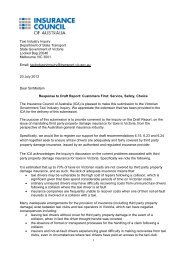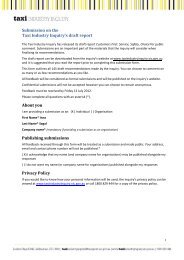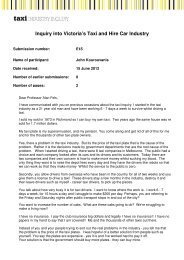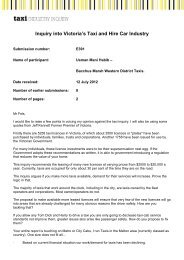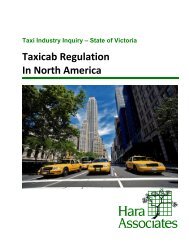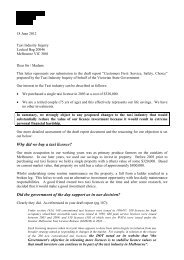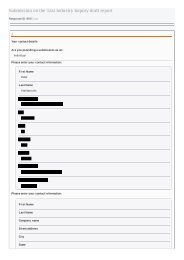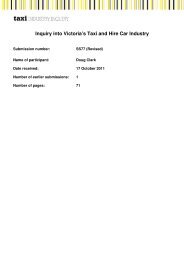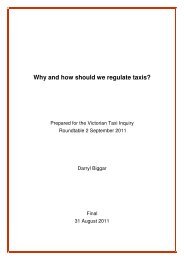Part D â Understanding and improving industry performance (PDF ...
Part D â Understanding and improving industry performance (PDF ...
Part D â Understanding and improving industry performance (PDF ...
Create successful ePaper yourself
Turn your PDF publications into a flip-book with our unique Google optimized e-Paper software.
Figure 10.3 Comparison of community gains from fare reductions <strong>and</strong> from greater availability<br />
Fare reduction<br />
Greater availability<br />
Fares<br />
Fares<br />
Community gain = B - A<br />
Community gain<br />
B<br />
f 0<br />
Q 0<br />
Q 1<br />
Taxi trips or kms<br />
f 0<br />
Q 0<br />
Q 1<br />
Taxi trips or kms<br />
f 1<br />
c 0<br />
A<br />
Dem<strong>and</strong> 10 min wait<br />
Dem<strong>and</strong> 5 min wait<br />
Dem<strong>and</strong> 10 min wait<br />
Source: TII<br />
The inquiry also notes that the above analysis means<br />
that simple comparisons about fares across jurisdictions<br />
with different entry policies can often be misleading.<br />
In particular, even if fares are lower in a closed entry<br />
system, this does not imply consumers are better off.<br />
The availability effect means that consumers can actually<br />
be better off even if they pay higher fares; even a small<br />
increase in availability may have significant positive effects<br />
because the value created by shifts in dem<strong>and</strong> (caused by<br />
better availability) outweigh the losses from higher fares.<br />
The New Zeal<strong>and</strong> experience appears to be a good<br />
example of this effect. As highlighted in chapter 9,<br />
fares are somewhat higher in New Zeal<strong>and</strong> than in<br />
Australian cities, yet there are many more taxis operating<br />
sustainably in New Zeal<strong>and</strong>. Consumers may well be<br />
better off due to greater taxi availability than in the<br />
Australian closed entry systems. Ultimately, this depends<br />
on whether more trips are consumed <strong>and</strong> how much<br />
consumers value these trips.<br />
A better approach to measuring possible welfare<br />
gains from removing or reducing entry restrictions is to<br />
take the dem<strong>and</strong> <strong>and</strong> supply interaction into account.<br />
This introduces an additional source of complexity<br />
into estimations of the likely effects of removing<br />
entry restrictions <strong>and</strong>/or lowering fares. Given these<br />
constraints, it is helpful to classify the kind of results that<br />
might be expected from removing entry restrictions under<br />
a number of scenarios.<br />
1. Waiting time effect is not significant, lower prices<br />
with number of taxis unchanging<br />
2. Waiting time effect is not significant, prices<br />
unchanging with more taxis entering<br />
3. Waiting time effect is significant, lower prices with<br />
number of taxis unchanging<br />
4. Waiting time effect is significant, prices unchanging<br />
with more taxis entering<br />
The likely outcomes of different policies around entry <strong>and</strong><br />
fares, in comparison with the current situation, are shown<br />
in Table 10.2.<br />
Table 10.2 Likely welfare outcomes compared to existing situation<br />
Outcome compared to existing situation<br />
Waiting time effect<br />
Significant<br />
Not significant<br />
Policy<br />
change<br />
Lower price, number of taxis fixed<br />
Price fixed, number of taxis increases<br />
Worse<br />
Consumers value availability more<br />
than lower fares<br />
Better<br />
More availability stimulates<br />
substantial new dem<strong>and</strong><br />
Better<br />
Consumers value lower fares more<br />
than better availability<br />
Worse<br />
‘Excess’ entry <strong>and</strong> too many taxis<br />
service passengers<br />
196





